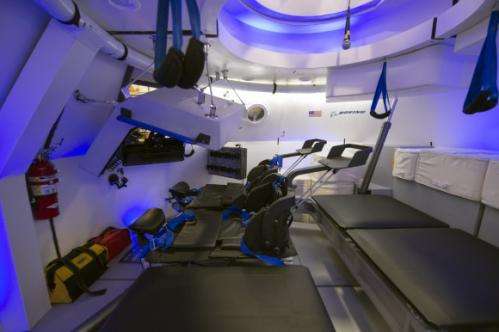This is an interior view of The Boeing Company’s CST-100 spacecraft, which features LED lighting and tablet technology. Credit: NASA/Robert Markowitz
A pair of NASA astronauts donned their spacesuits for key fit check evaluations inside a test version of the Boeing Company's CST-100 commercial 'space taxi' which was unveiled this week for the world's first glimpse of the cabin's interior.
Boeing is among a trio of American aerospace firms, including SpaceX and Sierra Nevada Corp, seeking to restore America's capability to fly humans to Earth orbit and the space station using seed money from NASA's Commercial Crew Program (CCP).
Astronauts Serena Aunon and Randy Bresnik conducted a day long series of technical evaluations inside a full scale mock up of the CST-100, while wearing NASA's iconic orange launch-and-entry flight suits.
During the tests, Boeing technicians monitored the astronauts ergonomic ability to work in the seats and move around during hands on use of the capsules equipment, display consoles and storage compartments.
The purpose of the testing at Boeing's Houston Product Support Center is to see what works well and what needs modifications before fixing the final capsule design for construction.
"It's an upgrade," said astronaut Serena Aunon at the evaluation. "It is an American vehicle, of course it is an upgrade."
Former NASA Astronaut Chris Ferguson, the commander of the final shuttle flight (STS-135) by Atlantis, is leading Boeing's test effort as the director of Boeing's Crew and Mission Operations.
"These are our customers. They're the ones who will take our spacecraft into flight, and if we're not building it the way they want it we're doing something wrong," said Ferguson.
"We'll probably make one more go-around and make sure that everything is just the way they like it."
The CST-100 is designed to carry a crew of up to 7 astronauts, or a mix of cargo and crew, on missions to low-Earth orbit (LEO) and the International Space Station (ISS) around the middle of this decade.
Although it resembles Boeing's Apollo-era capsules from the outside, the interior employs state of the art modern technology including sky blue LED lighting and tablet technology.
Provided by Universe Today






















